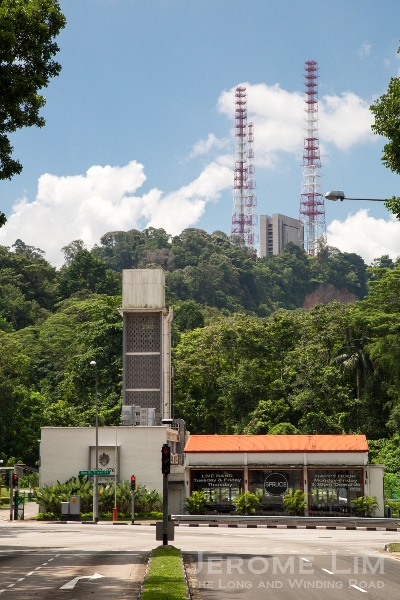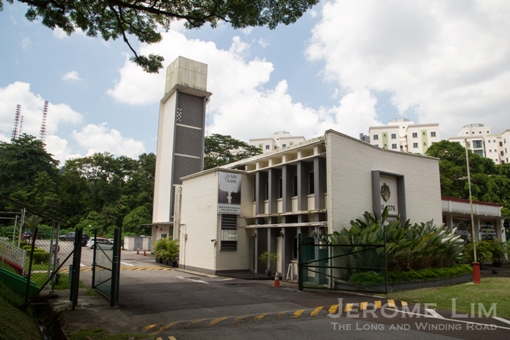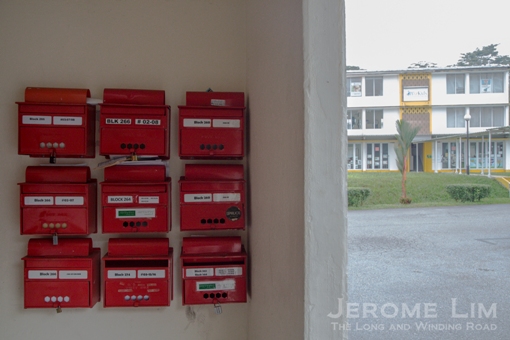One of those things almost every young boy dreams of becoming is a fireman. I had myself harboured ambitions of becoming one at different points during my childhood; the inspiration coming from picture books and what I must have caught on the television and perhaps from the constant reminder I had in the form of the rather eye-catching Alexandra Fire Station, which was close to where I lived in Queenstown.

The fire station at the 8MS, Bukit Timah Fire Station, a landmark in my many road journeys and a fire station of old marked by a distinctive hose-drying tower.
Sadly, that station is long gone. The monster of a building that replaced it, besides housing a fire station, also has a police centre operating from it. Without the distinctive hose-drying tower and red doors, the new building, unlike the stations of old, is no longer one to fuel the aspirations of childhood, and certainly not one in which I am able to reconnect with days that I often wish to return to.
That connection to my youthful days can fortunately be found in several other fire stations of old. Of these, the pretty red and white Central Fire Station, Singapore’s oldest and now a National Monument is still in operation. That, in the days of my childhood, loomed large at the far end of a street now lost, Hock Lam Street, along which I often found comfort in a bowl of its famous beef ball soup.
Two others that I regularly set my eyes upon, while still around, are no longer operational. One is the red brick former Serangoon or Kolam Ayer Fire Station, along Upper Serangoon Road. Now reassembled, having been moved due to the construction of a road where it had stood, the station was one that was close to my second home in Toa Payoh.
The other was Bukit Timah Fire Station. Sited at the 8th milestone Bukit Timah, it was close to the giant Green Spot bottle that stood tall at the Amoy Canning Factory (see: a photograph of the Green Spot bottle on James Tann’s wonderful Princess Elizabeth Estate blog) and was at the foot of Singapore’s highest hill. The station stood out as a landmark in the many road journeys of my childhood. The pair (the station and the giant replica bottle) seemed then to mark the edge of the urban world and on the long drives to the desolate north and the wild west, the sight of them would represent the start of the adventure on the outward journey, and would signal the return to civilisation on the journey home.

The former station, just after its closure (online at http://m5.i.pbase.com/u41/lhlim/upload/22296575.DSCF0029_02.jpg).
The former Bukit Timah Fire Station has a mention in the National Heritage Board’s Bukit Timah Heritage Trail booklet. This tells us that it was in 1956, the fourth fire station to be built; a fact that I assume is in relation to the stations that were built for the Singapore Fire Brigade, coming after Central Fire Station and the sub-stations at Geylang and Alexandra. Kolam Ayer (Serangoon), built for the volunteer Auxiliary Fire Service in 1954 would have already been standing at the time. That only came under the Singapore Fire Bridage in 1961, following the disbandment of the volunteer force. Another station that would have existed, was the Naval Base Fire Brigade’s Sembawang Fire Station. Built in the 1930s, the station’s building is now conserved.
Bukit Timah sub-station’s appearance, is perhaps one of the strongest clues to its vintage, its clean and understated elegance is typical of the 1950s Modernist style. One of the few adornments on its uncluttered façade, is a coat of arms. That of the Colony of Singapore, it is also is a telltale sign of when the station would have been commissioning – the coat of arms was in use during the days of the Crown Colony from 1948 to 1959.
The station’s grounds, also speak of the past. Besides a sign slowing us down to 20 miles per hour, there are many other signs of the times, the most noticeable of which would be the now recoloured low-rise apartment blocks. The blocks provide evidence of days when the various services provided for the accommodation needs of servicemen and their families as well as point to a period in our history when Singapore, even if administered by the colonial masters as a separate entity, was a part of the greater Malaya. It would have been common then to find men in service hailing not just from the Crown Colony but also from parts of the Federation. The seven three-storey blocks, each with six comfortably proportioned apartments, are in the company of a single storey house at the back, which would have been the residence of the station master.
Having been in operation for close to half a century, the station was to close its red doors for good in 2005 when a larger and modern replacement at Bukit Batok Road was built. Missing from the new station was the hose-drying tower that once seemed to be the defining feature of a fire station. The introduction of machines to handle tasks such as the drying of hoses meant that stations built from 1987, starting with the one in Woodlands, would take on a new appearance.
One of several former stations still standing, only the buildings belonging to Bukit Timah have found interim uses. These were initially leased out by the State for three years in April 2008 to serve as a venue for corporate events, adventure camps, arts, education and sports.
Since then, the premises has seen a second master tenant leasing the property on a 2+2 year term, with whom it was relaunched as a lifestyle and education hub in 2012. Besides the take-up of units in the former quarters by businesses running enrichment activities aimed at the young, there is also a food and beverage outlet that now operates out of the station’s former garage.
As of today, the buildings do not have conservation status. There is hope however for their future retention, even if the current edition of the Urban Redevelopment Authority (URA) Master Plan seems to suggest otherwise. A Request for Proposal (RFP) for a Concept Master Plan for the Rail Corridor initiated by the URA identifies the former station as one of four activity hubs for which shortlisted teams are required to submit a concept design in which the buildings are retained and “repurposed for uses that complement its function as a gateway into the Rail Corridor” (see A new journey through Tanjong Pagar begins).
It would certainly be a cause for celebration should this happen. The station, as one of the last to survive from an era during which the area developed as a industrial corridor and as a prominent landmark, serves not just as a link to the area’s development and history, but also as a reminder of a Singapore we might otherwise be quick to forget.























































































Leave a comment